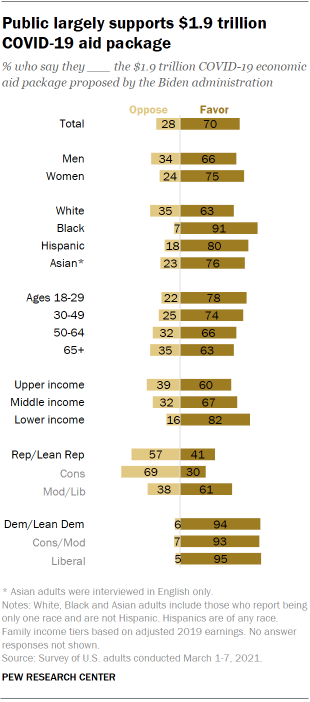More Americans say the Biden administration made a ‘good faith’ effort working with opposition than say the same of GOP leaders
Pew Research Center conducted this study to understand the public’s views of the economic aid package proposed by the Biden administration in response to the coronavirus outbreak . For this analysis, we surveyed 12,055 U.S. adults in March 2021. Everyone who took part in this survey is a member of Pew Research Center’s American Trends Panel (ATP), an online survey panel that is recruited through national, random sampling of residential addresses. This way nearly all U.S. adults have a chance of selection. The survey is weighted to be representative of the U.S. adult population by gender, race, ethnicity, partisan affiliation, education and other categories. Read more about the ATP’s methodology.
Here are the questions used for the report, along with responses, and its methodology.

As the House of Representatives prepares to give final approval to the Biden administration’s $1.9 trillion coronavirus relief package, a sizable majority of U.S. adults (70%) say they favor the legislation. Only about three-in-ten (28%) oppose the bill, which provides economic aid to businesses, individuals and state and local governments.
While congressional votes on the legislation have been deeply divided along partisan lines, 41% of Republicans and Republican-leaning independents support the measure. The bill draws overwhelming support from Democrats and Democratic leaners (94% favor).

In assessing the proposed spending in the aid package, 41% of Americans view it as about right, while another 25% say it spends too little; only a third of Americans say the legislation spends too much money. Republicans are far more likely than Democrats to view the spending in the bill as excessive (61% of Republicans vs. 11% of Democrats).
The new national survey by Pew Research Center, conducted on the Center’s nationally representative American Trends Panel March 1-7, 2021, among 12,055 adults, finds that a majority of the public (57%) says the Biden administration made a good faith effort working with Republican congressional leaders on the coronavirus aid package.
By comparison, 42% say GOP leaders made a good faith effort to work with the White House on the pandemic relief bill, with a 55% majority saying they did not work in good faith.
Across demographic groups, large shares of the public support the federal aid package

While most Americans favor the coronavirus aid package, there are demographic differences in the levels of support.
Three-quarters of women say they favor the aid package, while a smaller majority of men (66%) say the same.
While overwhelming majorities of Black (91%), Hispanic (80%) and Asian American adults (76%) say they favor the economic package, that compares with a smaller majority of White adults (63%).
There are also substantial differences in views of the economic stimulus package by household income. About eight-in-ten Americans in lower-income households (82%) favor the bill, compared with two-thirds of middle-income and 60% of upper-income Americans.
Although a 57% majority of Republicans say they oppose the proposed stimulus bill, there is a substantial ideological divide within the GOP: Roughly seven-in-ten conservative Republicans (69%) say they oppose the economic package, while the balance of opinion is reversed among moderate and liberal Republicans, 61% of whom say they favor the aid bill.
By contrast, there is near-universal support for the economic bill among Democrats: More than nine-in-ten (94%) say they favor the COVID-19 economic aid package.

Among Republicans, there are wide differences in support for the economic package by household income. A 63% majority of lower-income Republicans and Republican leaners (who make up 25% of all Republicans and Republican leaners) say they favor the proposed economic package. By comparison, 37% of Republicans in middle-income households (50% of Republicans) and just 25% of upper-income Republicans (21% of all Republicans) favor the bill.
There are no substantial differences by income among Democrats.
About four-in-ten Americans (41%) say the proposed spending on the bill is about right, while a third say the proposed spending in the bill is too much and a quarter say the amount of allocated money is too little.

While about four-in-ten of those in all income groups say the spending in the aid package is “about right,” Americans with lower incomes are more likely than others to say the amount of spending in the COVID-19 economic package is “too little” (and less likely to say it is “too much”).
About four-in-ten lower-income Americans (37%) say the bill spends too little, compared with 22% of middle-income and 13% of upper-income Americans. Conversely, 46% of upper-income Americans say the bill spends too much; just 20% of lower-income Americans say this.
Partisans also differ in these views: A majority of Democrats (56%) say spending for the bill is about right, with a third saying it is too little and just 11% saying it is too much. In contrast, most Republicans (61%) say the bill is spending too much.
Reflecting the income pattern among all Americans, within both partisan groups, those with lower incomes are more likely than those with higher incomes to say the proposed spending on the economic bill is not enough.
For example, while more than a quarter of lower-income Republicans (27%) say the proposed spending in the aid package is too little, just 11% of middle-income and 6% of upper-income Republicans say the same. Fully 81% of upper-income Republicans say the proposed spending in the economic aid package is too much, a view held by 42% of lower income Republicans.
Similarly, lower-income Democrats (42%) are more than twice as likely as upper-income Democrats (20%) to say that spending is too little. Still, half or more Democrats across income levels say the level of spending is about right.